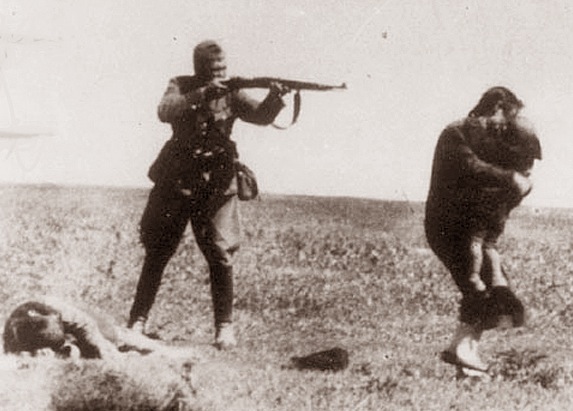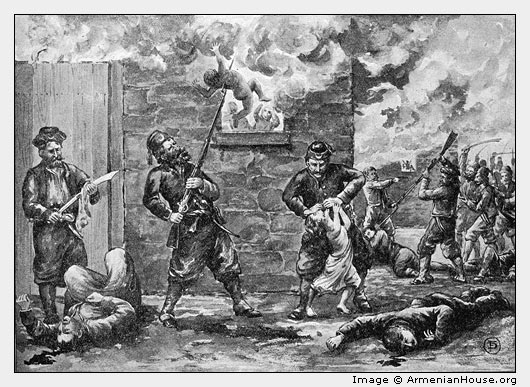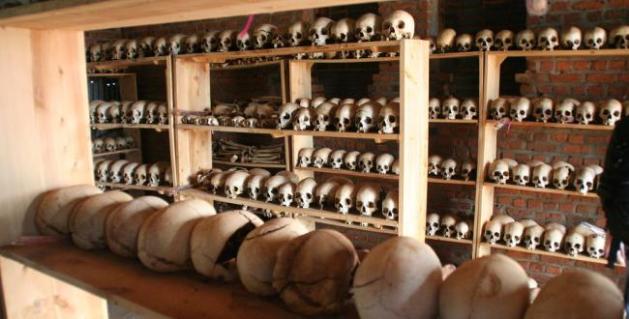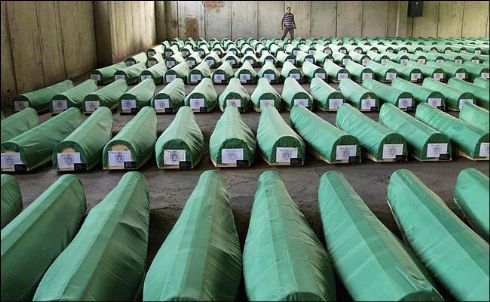Good books and films about The Holocaust
April 28, 2011 3 Comments

Holocaust. A mother tries to save her child
April is Genocide Awareness and Prevention Month. In honor of this, we have compiled a Resource List of books and films themed around each of the past genocides that have commemorative dates in April, plus the areas that we cover.
We hope you will make use of this list as a way to both remember these genocides, and learn more about them. This is our sixth post, The Holocaust.
Recommended Books:
All But My Life, by Gerda Weissman Klein
Gerda was a teenager during the Holocaust, when she lost her home, her friends and her family. After many years of torture, she was finally rescued. This is her memoir of her early life, six years in the concentration camps and liberation by American troops, one of whom later became her husband.
Auschwitz, A New History, by Laurence Rees
The author provides a portrait of the death camp through more than 100 original interviews with survivors and perpetrators. The story of the camp becomes a morality tale in which evil is shown to proceed until the horror of the slaughter that was inflicted in Auschwitz.
Berlin Diaries 1940-1945, by Marie Vassiltchikov *favorite
The secret diaries of a 23-year old White Russian princess who worked in the German Foreign Office from 1940-1944 and then as a nurse, weaving history, memoir and autobiography.
Children of the Holocaust: Conversations with Sons and Daughters of Survivors, by Helen Epstein
This daughter of Holocaust survivors interviewed hundreds of other descendants of survivors in America, Europe and Israel and tells their stories.
Crystal Night, by Rita Thalman and Emmanuel Feinermann
This documentary, based on contemporary documents from both the Nazis and their victims, recreates the night of November 9-10, 1938, when Nazi terrorism of the Jews climaxed in nationwide riots, a foreshadowing of the Holocaust.
Diary of Anne Frank, by Anne Frank
Discovered in the attic in which she spent the last years of her life, Anne Frank’s remarkable diary has become a powerful reminder of the horrors of war and an eloquent testament to the human spirit. This vivid, insightful journal is a fitting memorial to the gifted Jewish teenager who died at Bergen-Belsen, Germany, in 1945.
Man’s Search for Meaning, by Viktor E. Frankl
Viktor E. Frankl is among the most influential works of psychiatric literature since Freud. The book begins with a lengthy, austere, and deeply moving personal essay about Frankl’s imprisonment in Auschwitz and other concentration camps for five years, and his struggle during this time to find reasons to live.
Night, by Elie Wiesel
Elie Wiesel’s memoir Night, a scholarly, pious teenager is wracked with guilt at having survived the horror of the Holocaust and the genocidal campaign that consumed his family. His memories of the nightmare world of the death camps present him with an intolerable question: how can the God he once so fervently believed in have allowed these monstrous events to occur.
Official Secrets: What the Nazis Planned, What the British and Americans Knew, by Richard Breitman
The author examines how and when German leaders carried out the policies that led to and implemented the Holocaust. He assesses the British and American responses to information about Nazi killings and the tension between them in 1942-43 over what to do. He concludes by examining consequences of having kept this information secret for so long.
Silvie, by Sylvia Grohs-Martin
The story of this actress, dancer and singer who worked at a Jewish theater in Amsterdam, worked with the Dutch resistance, and then survived the horrors of Auschwitz and two other concentration camps.
Suite Francaise, by Irene Nemirovsky *favorite
This book contains two narratives, one fictional and the other a fragmentary, factual account of how the fiction came into being. Suite Française consists of two novellas portraying life in France from June 4, 1940, as German forces prepare to invade Paris, through July 1, 1941. A series of appendices and a biographical sketch provide information about the author who was arrested in 1942 and died in Auschwitz a month later.
The Hiding Place, by Corrie Ten Boom with Elizabeth Sherrill and John Sherrill
In World War II, Corrie ten Boom and her family risked their lives to help Jews escape the Nazis, and their reward was a trip to Hitler’s concentration camps. But she survived and was released–as a result of a clerical error–and now shares the story of how faith triumphs over evil.
The Holocaust Kingdom, by Alexander Donat
This memoir of a Polish-Jewish family who survived the Warsaw Ghetto as well as concentration and death camps reaches beyond their personal experience to capture the story of doomed millions.
The Words to Remember It: Memoirs of Child Holocaust Survivors, by Sydney Child Holocaust Survivors Group
The 31 members of the Sydney Child Holocaust Survivors Group share personal stories of their unfathomable experiences of loss—and of their ultimate endurance—from their youths in Nazi Germany.
War Orphan in San Francisco, by Phyllis Helene Mattson
In 1940, 10-year old Lizzi left Vienna, Austria, joining a transport of children seeking refuge in America. Two weeks later she began e new life in San Francisco. Her family was scattered on three continents, but linked by letters. Her story is told through the letters in this memoir.
Recommended Films:
The Boy in the Striped Pajamas *favorite
Set during World War II, a story seen through the innocent eyes of Bruno, the eight-year-old son of the commandant at a concentration camp, whose forbidden friendship with a Jewish boy on the other side of the camp fence has startling and unexpected consequences.
Defiance
This film involves an unusual group of brothers who run off into the woods after the Nazis kill their family and neighbors — and then wind up playing leaders to other Jews who wander into the woods as well. This is a true story and some of it is a bit difficult to watch.
Forgiving Dr. Mengele
Eva Mozes Kor, who survived Josef Mengele’s cruel twin experiments in the Auschwitz concentration camp, shocks other Holocaust survivors when she decides to forgive the perpetrators as a way of self-healing.
Life Is Beautiful
A Jewish man has a wonderful romance with the help of his humour, but must use that same quality to protect his son in a Nazi death camp.
Night and Fog
The history of Nazi Germany’s death camps of the Final Solution and the hellish world of dehumanization and death contained inside.
The Pianist
This is the true story of Jewish pianist Wladyslaw Szpilman. Set in Poland, it runs through a number of ridiculous edicts tossed out by the Nazis. It depicts the relocation of Jewish families into the ghettos. It shows the walls closing in a little more every day, until finally there is nothing left.
Schindler’s List
In Poland during World War II, Oskar Schindler gradually becomes concerned for his Jewish workforce after witnessing their persecution by the Nazis.
Shoah *favorite
Claude Lanzmann directed this 9 1/2 hour documentary of the Holocaust without using a single frame of archive footage. He interviews survivors, witnesses, and ex-Nazis (whom he had to film secretly since though only agreed to be interviewed by audio).
Background on The Holocaust: After coming to power in 1933 on the basis of providing an ethnic and political scapegoat for Germany’s post-World War I problems , the Nazi Party implemented a highly organized strategy of the persecution and murder of “undesireables” including Jews, Slavs, Roma, the disabled, Jehovah’s Witnessess, homosexuals, as well as political and religious dissidents. The Nazis promulgation of the Nuremburg Laws stripped citizenship from German Jews on the basis of their religious identity. Shortly thereafter, in November 1938, the organized pogrom of Kristallnacht signaled a change in policy, featuring the mass deportations of German Jews to concentration camps. As the Nazis conquered large areas of Europe, Jews and other undesirables across Nazi-controlled areas were similarly deported. When the German Army invaded the Soviet Union, it soon gave rise to Einsatzgruppen, mobile killing squads operating throughout Eastern Europe and Russia, killing more than one million Jews and tens of thousands of other civilians. In 1942, a conference at Wansee developed the Final Solution to the Jewish Question, the systematic extermination of European Jewry. The construction of extermination camps at Auschwitz-Birkanau, Treblinka, Belzec, Chelmno and Sobibor enabled the Nazis to kill 2.7 million Jews and other “undesirables” through the use of cyanide gas, summary executions and medical experimentation. Poor living conditions in non-extermination camps led to the deaths of millions more. It is estimated that 6 million Jews, two out of every three living in Europe, and another 5 million undesirables were killed by 1945.
– From GI-Net / Save Darfur Coalition (link)
Compiled by Paulina Robles and Barbara English of Orange County for Darfur and Martina Knee of the San Francisco Bay Area Darfur Coalition.






